Understanding the Significance of Membrane Switches in Interface
Membrane switches are essential elements in the layout of efficient customer interfaces, assisting in not only functionality but additionally improving aesthetic allure and individual communication. Their distinct features, such as resistance to customizable designs and ecological elements, make them suitable for a varied array of applications throughout numerous industries. As we check out the future trends and various advantages connected with Membrane technology, it ends up being clear that these switches are greater than simply components; they stand for a merging of advancement and usefulness. The implications of this technology on user experience are worth examining further.
What Are Membrane Buttons?

The spacer layer, which has glue residential properties, enables the splitting up of the circuit layer from the overlay, making certain that the button continues to be in a non-activated state till pushed. When pressure is related to the overlay, it presses the spacer layer, linking the void and finishing the circuit in the underlying layer. This style not only lowers the physical room required for conventional mechanical switches but additionally improves the sturdiness of the device, as Membrane buttons are typically resistant to dust, moisture, and various other environmental factors.
Generally discovered in applications ranging from customer electronic devices to clinical tools, Membrane buttons are integral to modern technology, giving a effective and user-friendly interface that lines up with contemporary style requirements.
Benefits of Membrane Switches
While countless switch innovations exist, Membrane Switches offer distinct advantages that make them especially preferable in numerous applications. Among the main benefits of Membrane buttons is their compact layout, which permits for space-saving applications in gadgets where realty is restricted. Their slim profile not just improves aesthetic charm but likewise helps with lightweight building and construction.
An additional considerable benefit is their resistance to ecological factors. Membrane buttons are generally sealed versus moisture, dirt, and contaminants, making them excellent for use sought after environments, such as medical gadgets and industrial tools. This resilience expands the life expectancy of the button, reducing maintenance prices and improving reliability.
Additionally, Membrane switches can be personalized to fulfill specific style needs, including distinct graphics and shades that boost user interaction. Their tactile feedback options can also be customized to give a gratifying user experience. In addition, Membrane buttons are cost-efficient, especially in high-volume applications, as they can be created effectively.
Applications in Various Industries

In the customer electronic devices sector, Membrane switches are common in gadgets such as microwaves, cleaning devices, and push-button controls. Their responsive comments and aesthetic choices enhance user experience while offering a streamlined, modern appearance. In addition, automotive producers use Membrane switches in control panel controls and infomercial systems, where area is limited, and user interaction is vital.
Additionally, the commercial market leverages Membrane buttons in control panels for equipment and devices, permitting intuitive operation in typically rough atmospheres. Their resistance to chemicals and dampness guarantees durability and reliability in these applications. Overall, the flexibility of Membrane Switches adds substantially to their widespread use, making them crucial in various technical domains.
Layout Factors To Consider for Membrane Switches

When developing Membrane switches, a number of vital this link factors to consider must be taken into account to ensure ideal functionality and individual experience. The option of materials is vital; choosing long lasting, top notch substratums can boost the button's long life and resistance to ecological variables such as dampness and temperature level variations.
Second of all, the style of the graphic overlay ought to prioritize clarity and ease of use. Symbols and message have to be legible, and the design must help with user-friendly communication (membrane switches). In addition, responsive responses is necessary; including a tactile i thought about this dome or various other systems can improve the individual experience by giving physical confirmation of activation
Another vital factor is the switch's electrical efficiency. Developers have to ensure that the conductive traces are properly designed to minimize resistance and avoid signal interference. This involves analyzing the needed actuation force and making sure compatibility with the digital elements they will interface with.

Future Fads in Membrane Modern Technology
As innovation proceeds to development, Membrane buttons are positioned to advance dramatically, driven by innovations in products and producing methods. One emerging trend is the unification of advanced materials, such as conductive inks and flexible substrates, which enhance toughness and reduce the general weight of Membrane buttons. These materials not just boost the tactile reaction yet also permit for the design of buttons that can stand up to harsher ecological problems.
Additionally, the combination of touch-sensitive innovations is changing standard Membrane Switches into more interactive individual interfaces. Capacitive touch sensors embedded within Membrane switch panels can supply a more user-friendly and responsive customer their website experience, straightening with the growing need for sleek, modern-day designs in customer electronics.
Additionally, advancements in printing methods, such as electronic and 3D printing, make it possible for rapid prototyping and personalization of Membrane buttons. This flexibility allows producers to respond faster to market demands and customer preferences.
Finally, sustainability is ending up being a considerable emphasis, with suppliers exploring eco-friendly materials and procedures. As these patterns unfold, the future of Membrane modern technology promises boosted performance, aesthetic appeal, and ecological duty, strengthening their duty in innovative customer interfaces across various markets.
Final Thought
In conclusion, Membrane Switches stand for a crucial element in the style of customer interfaces, incorporating performance with visual versatility. As innovations in modern technology proceed, the development of Membrane switches is anticipated to further fine-tune individual interfaces, driving technology and improving usability in a progressively complicated technological landscape.
Membrane buttons are important components in the style of reliable user interfaces, helping with not just functionality however likewise boosting visual appeal and individual communication.Membrane Switches serve as an important component in different customer interfaces, facilitating a smooth communication between individuals and electronic tools.While countless button technologies exist, Membrane Switches deal distinct benefits that make them especially desirable in numerous applications.Additionally, Membrane buttons can be tailored to fulfill particular style needs, including unique graphics and shades that improve user interaction.In final thought, Membrane Switches represent a crucial element in the style of individual interfaces, incorporating capability with aesthetic adaptability.